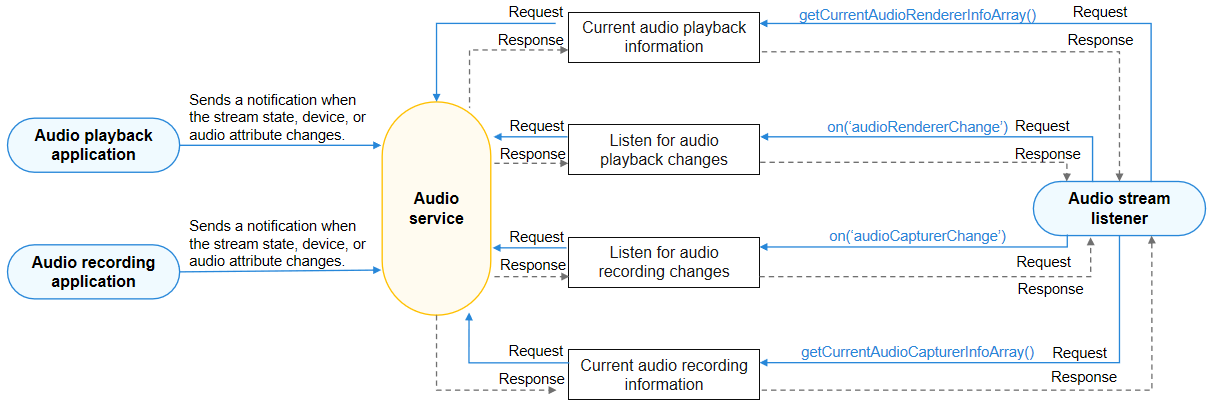Audio Recording Stream Management
An audio recording application must notice audio stream state changes and perform corresponding operations. For example, when detecting that the user stops recording, the application must notify the user that the recording finishes.
Reading or Listening for Audio Stream State Changes in the Application
Create an AudioCapturer by referring to Using AudioCapturer for Audio Recording or audio.createAudioCapturer. Then obtain the audio stream state changes in either of the following ways:
-
Check the state of the AudioCapturer.
let audioCapturerState: audio.AudioState = audioCapturer.state; console.info(`Current state is: ${audioCapturerState }`) -
Register stateChange to listen for state changes of the AudioCapturer.
audioCapturer.on('stateChange', (capturerState: audio.AudioState) => { console.info(`State change to: ${capturerState}`) });
The application then performs an operation, for example, displays a message indicating the end of the recording, by comparing the obtained state with AudioState.
Reading or Listening for Changes in All Audio Streams
If an application needs to obtain the change information about all audio streams, it can use AudioStreamManager to read or listen for the changes of all audio streams.
NOTE
The audio stream change information marked as the system API can be viewed only by system applications.
The figure below shows the call relationship of audio stream management.

During application development, first use getStreamManager() to create an AudioStreamManager instance. Then call on('audioCapturerChange') to listen for audio stream changes and obtain a notification when the audio stream state or device changes. To cancel the listening for these changes, call off('audioCapturerChange'). You can call getCurrentAudioCapturerInfoArray() to obtain information such as the unique ID of the recording stream, UID of the recording stream client, and stream status.
For details about the APIs, see AudioStreamManager.
How to Develop
-
Create an AudioStreamManager instance.
Before using AudioStreamManager APIs, you must use getStreamManager() to create an AudioStreamManager instance.
import audio from '@ohos.multimedia.audio'; import { BusinessError } from '@ohos.base'; let audioManager = audio.getAudioManager(); let audioStreamManager = audioManager.getStreamManager(); -
Use on('audioCapturerChange') to listen for audio recording stream changes. If the application needs to receive a notification when the audio recording stream state or device changes, it can subscribe to this event.
audioStreamManager.on('audioCapturerChange', (AudioCapturerChangeInfoArray: audio.AudioCapturerChangeInfoArray) => { for (let i = 0; i < AudioCapturerChangeInfoArray.length; i++) { console.info(`## CapChange on is called for element ${i} ##`); console.info(`StreamId for ${i} is: ${AudioCapturerChangeInfoArray[i].streamId}`); console.info(`Source for ${i} is: ${AudioCapturerChangeInfoArray[i].capturerInfo.source}`); console.info(`Flag ${i} is: ${AudioCapturerChangeInfoArray[i].capturerInfo.capturerFlags}`); let devDescriptor: audio.AudioDeviceDescriptors = AudioCapturerChangeInfoArray[i].deviceDescriptors; for (let j = 0; j < AudioCapturerChangeInfoArray[i].deviceDescriptors.length; j++) { console.info(`Id: ${i} : ${AudioCapturerChangeInfoArray[i].deviceDescriptors[j].id}`); console.info(`Type: ${i} : ${AudioCapturerChangeInfoArray[i].deviceDescriptors[j].deviceType}`); console.info(`Role: ${i} : ${AudioCapturerChangeInfoArray[i].deviceDescriptors[j].deviceRole}`); console.info(`Name: ${i} : ${AudioCapturerChangeInfoArray[i].deviceDescriptors[j].name}`); console.info(`Address: ${i} : ${AudioCapturerChangeInfoArray[i].deviceDescriptors[j].address}`); console.info(`SampleRates: ${i} : ${AudioCapturerChangeInfoArray[i].deviceDescriptors[j].sampleRates[0]}`); console.info(`ChannelCounts ${i} : ${AudioCapturerChangeInfoArray[i].deviceDescriptors[j].channelCounts[0]}`); console.info(`ChannelMask: ${i} : ${AudioCapturerChangeInfoArray[i].deviceDescriptors[j].channelMasks}`); } } }); -
(Optional) Use off('audioCapturerChange') to cancel listening for audio recording stream changes.
audioStreamManager.off('audioCapturerChange'); console.info('CapturerChange Off is called'); -
(Optional) Call getCurrentAudioCapturerInfoArray() to obtain information about the current audio recording stream.
This API can be used to obtain the unique ID of the audio recording stream, UID of the audio recording client, audio status, and other information about the AudioCapturer.
NOTE
Before listening for state changes of all audio streams, the application must declare the ohos.permission.USE_BLUETOOTH permission, for the device name and device address (Bluetooth related attributes) to be displayed correctly.
async function getCurrentAudioCapturerInfoArray(){ await audioStreamManager.getCurrentAudioCapturerInfoArray().then((AudioCapturerChangeInfoArray: audio.AudioCapturerChangeInfoArray) => { console.info('getCurrentAudioCapturerInfoArray Get Promise Called '); if (AudioCapturerChangeInfoArray != null) { for (let i = 0; i < AudioCapturerChangeInfoArray.length; i++) { console.info(`StreamId for ${i} is: ${AudioCapturerChangeInfoArray[i].streamId}`); console.info(`Source for ${i} is: ${AudioCapturerChangeInfoArray[i].capturerInfo.source}`); console.info(`Flag ${i} is: ${AudioCapturerChangeInfoArray[i].capturerInfo.capturerFlags}`); for (let j = 0; j < AudioCapturerChangeInfoArray[i].deviceDescriptors.length; j++) { console.info(`Id: ${i} : ${AudioCapturerChangeInfoArray[i].deviceDescriptors[j].id}`); console.info(`Type: ${i} : ${AudioCapturerChangeInfoArray[i].deviceDescriptors[j].deviceType}`); console.info(`Role: ${i} : ${AudioCapturerChangeInfoArray[i].deviceDescriptors[j].deviceRole}`); console.info(`Name: ${i} : ${AudioCapturerChangeInfoArray[i].deviceDescriptors[j].name}`); console.info(`Address: ${i} : ${AudioCapturerChangeInfoArray[i].deviceDescriptors[j].address}`); console.info(`SampleRates: ${i} : ${AudioCapturerChangeInfoArray[i].deviceDescriptors[j].sampleRates[0]}`); console.info(`ChannelCounts ${i} : ${AudioCapturerChangeInfoArray[i].deviceDescriptors[j].channelCounts[0]}`); console.info(`ChannelMask: ${i} : ${AudioCapturerChangeInfoArray[i].deviceDescriptors[j].channelMasks}`); } } } }).catch((err: BusinessError) => { console.error(`Invoke getCurrentAudioCapturerInfoArray failed, code is ${err.code}, message is ${err.message}`); }); }